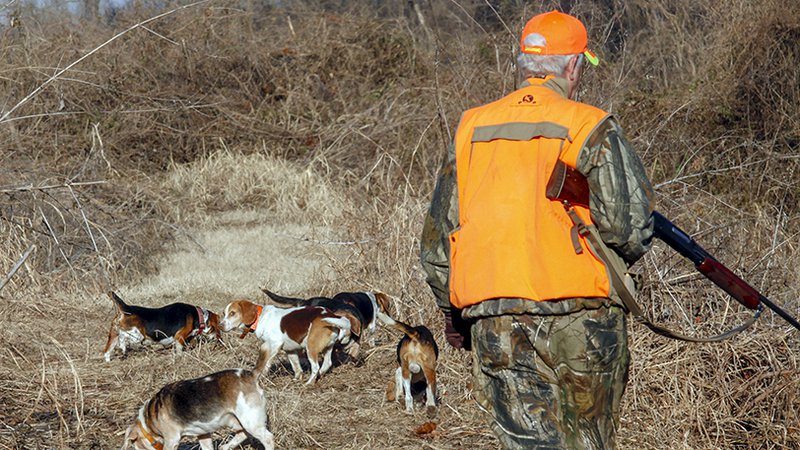Rabbit season comes with the cold
ON 12-12-2018

Dec. 12, 2018
Randy Zellers
Assistant Chief of Communications
LITTLE ROCK – With the majority of deer season having taken place in most of the state and freezing temperatures becoming regular events, many houndsmen are anxiously waiting for a chance to drop the tailgate and begin chasing their favorite quarry in earnest. For hunters who have never had the chance to participate in a rabbit race, the Arkansas Game and Fish Commission has put together a video on the easiest way to field dress and process rabbits and has posted it at www.agfc.com/en/hunting/small-game/rabbit.
Although rabbit season officially opens Sept. 1 each year, many rabbit hunters wait until winter before putting on their field boots and loading up the shotgun. Especially on public land, many rabbit hunters wait to give deer hunters plenty of time before their dogs begin working the woods for rabbits. Rabbit hunters also wait for the first few hard freezes and some of the vegetation to die back to make locating rabbits a little more predictable.
“The habitat favors the rabbit when everything is still green,” said Clifton Jackson, small game coordinator for the AGFC. “There’s a lot of different scents out there to throw off the beagles and a lot more cover spread across the landscape for rabbits to slip around in. But when the cold begins to fold all the grass and plants over, those rabbits will move to the brush piles and clumps where you can hone in a little more on them.”
Brushy edges near soybean and cotton fields can be real magnets for cottontails once harvest season is complete. Jackson says that many rabbits are used to the cover and food provided by the fields and are able to spread out during the early part of rabbit season, but as the crops are harvested, they have to seek shelter in nearby cover.
“Turnrows and edges are always worth looking into if you’re on private land,” Jackson said. “Rabbits aren’t going to stay out in that open ground, particularly in areas where you have a lot of hawks and owls waiting to pick them off.”
Jackson says this is actually a good time to be a hunter who’s interested in rabbit hunting. In years past, you had to have family or friends who knew rabbit hunters to be able to get started, but many social media groups and internet forums exist today where people can meet and learn more about the sport.
“I’d never just walk up to a random guy in the woods who’s running dogs and ask to join in, but now you can ask around much easier to see if someone would be willing to take you along on a hunt,” Jackson said. “You can meet, maybe go to lunch or something and get to know someone to decide if they are someone you want to go hunting with. And there are a lot of old-school rabbit hunters who are looking for every chance they can to run their dogs. Many don’t even care about the shooting anymore, but would be happy to take along a newcomer to shoot a couple of rabbits as long as they have a chance to get to know the new hunter first.”
Even hunters who do not have a dog can still give rabbit hunting a shot when the cold has driven them to the brush. According to Jackson, he never misses a chance to kick a likely brush pile whether the dogs are running a rabbit or not.
“You need to have your gun ready because it will dart out quickly,” Jackson said. “After a while you’ll start to recognize which types of brush are most likely to hold a rabbit. It just takes a lot more legwork to push them out of cover.”
Nearly all AGFC wildlife management areas are open for rabbit hunting, and so are some – not all – of the national wildlife refuges in the state. The open refuges are Bald Knob, Big Lake, Cache River, Wapanocca and White River’s North Unit. Although hunters on wildlife refuges should check their regulations regarding non-toxic shot, as lead is not allowed for any game on those areas.
“With most of our WMAs, you’re probably going to find swamp rabbits a little easier,” Jackson said. “Most of our areas contain bottomland hardwoods, and the swampers prefer that habitat where they can eat the shoots of woody plants. Swamp rabbits also will be found in woods near flooded areas of moist-soil units that are managed for waterfowl. The water will push them out of those units, but they won’t travel too far.”
The daily limit for rabbits is eight, and the season lasts until the end of February.
Recent News

Arkansas Wildlife Weekly Fishing Report
Jul. 10, 2025

Lonoke aquaculturist named to AGFC
Jul. 10, 2025
Subscribe to Our Weekly Newsletter E-mails
Don’t miss another issue. Sign up now to receive the AGFC Wildlife Weekly Newsletter in your mailbox every Wednesday afternoon (Waterfowl Reports are published weekly during waterfowl season and periodically outside the season). Fishing Reports arrive on Thursdays. Fill in the following fields and hit submit. Thanks, and welcome!
